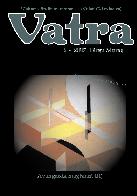Avangarda maghiară
The Hungarian Avantgarde
Author(s): Francisko Kocsis, Robert Reiter, Ernő Kállai, Miklós Radnóti, Lajos KassákSubject(s): Cultural Essay, Political Essay, Societal Essay
Published by: Vatra Literară
Summary/Abstract: Group of articles about the Hungarian avantgarde movement in the last century, whose exponents were József Attila, Illyés Gyula, Radnóti Miklós, Déry Tibor. Literature, ideology, fine arts, Synthetic literature. There are two manifests written by Kassak in the insurgent spirit of the age. He considered that all the literature up until then had reached a deadlock, without perspectives of evolution, because of a mannerist reflex. The two naturalist directions of the prose, of observation and analyses, arrived in the dry area of creation, where one can create only imitations with the same means. That is why, he searches for a way out of the previous existant state by combining the two directions and the revival of language. The direction contemplated by Kassak generated a real competition between the avant-gardists and resulted in an experimentalist effervescence with modest results, but out of which, through further clearings and through a synchronization with the neorealist German tendencies, a literature that easily asimilates modern elements and connetcs with no syncope at the European currents will be outlined. Kállai Ernő: The spiritual and social perspectives of the constructive art. He is a left wing art critic, theorethician of the constructive art. In his youth essays, he exaggerates the role of the new artistic orientation, convinced that it will become the great art of the future, in which the creator will implicate himself with his entire personality in imposing civilization masterpieces, thus becoming an active member of the society in a productive way. According to this conception, the artist is called to work at the social command, depending on the needs of the society, abandoning his old condition of solitary creator for ever, becoming a technologist, an architect and a builder of an idealistic world. Hevesy Istvan: Beyond impressionism He is the most important art critic of the inter-war age, a deep connoisseur of the artistic currents. This essay is a review of the apparition phases, explosion and decline these meteoric orientations knew, commenting from the receptor’s position the successes and the failures, the technical difficulties they confronted with and the sollutions they found. Moholy-Nagy László: From the Slice-Man to the Whole Man. The essay was initially published as a preface to his book Von Material zu Architektur ( From Substance to Architecture, 1929). The Hungarian version appeared a year later in Korunk magazine from Cluj (2/ 1930) and in 1979 it was republished under the title From Color to Light by Kriterion Publishing House from Bucharest. Portraits: 1. Moholy-Nagy László 2. Uitz Béla 3. Máttis Teutsch János 4. Bortnyik Sándor 5. Nemes Lampérth József
Journal: Revista Vatra
- Issue Year: 2007
- Issue No: 06
- Page Range: 17-90
- Page Count: 74
- Language: Romanian

